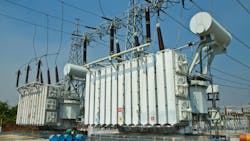DOE Selects Nine Projects to Receive About $20 Million Through Flexible Innovative Transformer Technologies Funding
The U.S. Department of Energy’s (DOE) Office of Electricity (OE) has selected nine projects to receive approximately $20 million through its Flexible Innovative Transformer Technologies (FITT) funding opportunity announcement (FOA) to advance key components helping modernize the grid.
OE also announced the eight winners of the Silicon Carbide (SiC) Packaging Prize Phase 1 who will receive $50,000 each in cash prizes (from a $400,000 total prize pool). The total $2.25 million prize, awarded in three phases, is part of the American-Made Challenges Program, which fosters collaboration between nation’s entrepreneurs and innovators, DOE’s National Labs, and the private sector.
The selected projects will address the technical challenges of advancing transformers through research, development, and demonstration across a range of distribution to transmission scale applications. DOE’s Office of Electricity (OE) and the Office of Cybersecurity, Energy Security, and Emergency Response (CESER) are co-funding this FOA, contributing $18 million and $2 million, respectively.
The selected FITT projects are:
- Clemson University (Clemson, SC) for Smart Hybrid transformer for Abnormal Power Events (SHAPE) ($2.47 million):
- Integrates solutions of medium voltage power electronics and battery storage into a distribution transformer to form a smart, hybrid transformer for abnormal power events.
- Eaton Corporation (Menomonee Falls, WI) for Compact and Reliable Voltage Regulating Hybrid Transformer ($2.94 million):
- Researches and tests a hybrid transformer to provide benefits within utility distribution networks and industrial sites.
- Electric Power Research Institute (Palo Alto, CA) for Solid State PowerHub Development and Demonstration ($2.88 million):
- Accelerates commercialization of an innovative solid-state transformer to accommodate input voltage variations ensuring stability.
- Electric Research and Manufacturing Cooperative (Dyerberg, TN) for the Distribution Transformer Extender (DTE) Project ($1.84 million):
- Develops and deploys devices to innovatively use power electronics to combine critical solid-state transformer functionality with a small BESS.
- GE Vernova Operations (Schenectady, NY) for Full-scale Alternating Current Solid-State Transformer Demonstration (FASST) ($1.99 million):
- Develops and deploys a one megavolt-amperes 3-winding, solid-state transformer to a public utility-owned substation to advance the technology’s commercial readiness.
- GE Vernova Operations (Schenectady, NY) for A Single-Phase Universal Spare Power Transformer for Grid Resilience ($2.99 million for topic area 2):
- Designs and deploys a single-phase 2-winding power transformer and solid-state tap changer to enable dynamic load balancing, power flow control, and fault current limiting capabilities.
- Resilient Power Systems (Austin, TX) for Direct Current-as-a-Service SolidFlex Power Hub: Revolutionizing Energy Distribution with Solid-State Transformer Technology ($1.47 million):
- Develops and demonstrates groundbreaking solid-state transformer technology to enhance efficiency, reliability, and flexibility in power distribution.
- Transforma Energy (Albuquerque, NM) for Drop-In Replacement Electronically Controlled Transformer (DIRECT) ($1.45 million):
- Proposes a solid-state transformer architecture to increase system robustness and applicability across a variety of voltage and power ratings.
- University of Pittsburgh (Pittsburgh, PA) for Enabling Technology and Grid-Tied Testbed for Efficient, Flexible, Intelligent Distribution Transformers ($2.5 million):
- Leverages industry partners to identify new technologies for evaluation, benchmarking, and maturation to lead to enabling next generation intelligent distribution transformers.
Silicon carbide (SiC) is used as the raw material for semiconductors as it can survive high electricity voltage fluctuations and temperatures. The winners will design, build, and test SiC semiconductor packaging prototypes to enable these devices to work more effectively in high-voltage environments such as energy storage.
SiC Prize Phase 1 winners are:
- Board Breakers (Fargo, North Dakota)
- This team is creating a replacement of traditional power electronic modules by using additive manufacturing to print 3D ceramic packaging.
- LincolnX (Lincoln, Nebraska)
- This team plans to develop novel ultrafast and scalable SiC modules featuring dual orthogonal cooling to meet the prize goals and metrics.
- Marel Power Solutions (Plymouth, Michigan)
- This team plans to make packaging improvements through thermal management, three-dimensional mechatronic design, and a scalable arrangement of power switches.
- NC Solar Inverters (Cary, North Carolina)
- Using commercially available topside cooled discrete devices, this team will utilize their designed symmetric layout to maximize parasitic flying capacitance and minimize parasitic inductance.
- NoMIS-Lux-QPT-UA (Albany, New York)
- This team, comprised of NoMIS, Lux, QPT, and UofA, will combine their technology and products in Smart Metal Core SiC power blocks to create high voltage chip-scale packaging..
- Stony Brook Power Packaging Team (Stony Brook, New York)
- This team will develop high-voltage, high-current, fast-switching, and cost-effective modules and create a business entity for engineering sampling and commercialization.
- Superior SiC Power Module Team (Gainesville, Florida)
- This team plans to develop an interdisciplinary approach for SiC power modules with high-speed, high-energy efficiency, and low EMI.
- Team Raiju - University of Arkansas (Fayetteville, Arkansas)
- This team will embed 128 SiC die in LTCC controlled by an active dV/dt voltage balancer and cooled with integrated microchannel busbars.
In Phase 2, winning teams from Phase 1 will develop a physical prototype of their SiC packaging solution meeting Phase 2 metrics. In this phase, teams are expected to send their prototypes to a national lab for testing to validate the metrics achieved. At the end of Phase 2, up to four winning teams will receive $250,000 each and become eligible to compete in Phase 3.
